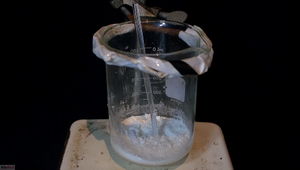Mercury(II) chloride
 Freshly prepared mercury(II) chloride
| |
| Names | |
|---|---|
| IUPAC names
Mercury(II) chloride
Mercury dichloride | |
| Other names
Corrosive sublimate
Dichloromercury Mercuric chloride Mercury bichloride | |
| Properties | |
| HgCl2 | |
| Molar mass | 271.52 g/mol |
| Appearance | White solid |
| Odor | Odorless |
| Density | 5.43 g/cm3 |
| Melting point | 276 °C (529 °F; 549 K) |
| Boiling point | 304 °C (579 °F; 577 K) |
| 3.6 g/100 ml (0 °C) 7.4 g/100 ml (20 °C) 48 g/100 ml (100 °C) | |
| Solubility | Soluble in glacial acetic acid, acetone, ethanol, ethyl acetate, formic acid, methanol, pentanol, THF Slightly soluble in benzene, carbon disulfide, pyridine |
| Solubility in benzene | 0.5 g/100 ml |
| Solubility in diethyl ether | 4 g/100 ml |
| Solubility in ethanol | 33 g/100 ml (25 °C) |
| Solubility in glycerol | 8.3 g/100 ml |
| Acidity (pKa) | 3.2 (0.2M solution) |
| Thermochemistry | |
| Std molar
entropy (S |
144 J·mol−1·K−1 |
| Std enthalpy of
formation (ΔfH |
−230 kJ/mol |
| Hazards | |
| Safety data sheet | Sigma-Aldrich |
| Flash point | Non-flammable |
| Related compounds | |
| Related compounds
|
Zinc chloride |
| Except where otherwise noted, data are given for materials in their standard state (at 25 °C [77 °F], 100 kPa). | |
| Infobox references | |
Mercury(II) chloride or mercuric chloride is the chemical compound of mercury and chlorine with the formula HgCl2.
Contents
Properties
Chemical
Mercury(II) chloride forms an amalgam with aluminium and prevents it from forming a protective oxide layer, which makes the metal susceptible to the action of water, alcohols. This property is exploited when synthesizing aluminium isopropoxide.
Physical
Mercuric chloride is a white solid, soluble in water and many organic solvents. It has the tendency to sublime.
Availability
Mercuric chloride is sold by chemical suppliers. It can also be sometimes found on eBay and Amazon.
The sale of mercury(II) chloride and most mercury compounds is restricted in many countries due to it's great toxicity. Its sale in EU is banned without a proper hazardous substance permit.
Preparation
Mercury(II) chloride cannot be made by directly reacting mercury to hydrochloric acid or chlorine. Instead, mercury is converted to mercury(II) nitrate by reacting it with conc. nitric acid, which is either calcinated to mercury(II) oxide and then hydrochloric acid is added. While it's possible to obtain mercuric chloride by reacting the mercury(II) nitrate with hydrochloric acid, it's best to avoid this as the reaction produces the dangerously corrosive and toxic nitrosyl chloride, and it's possible some mercury(II) nitrate might be left unreacted.
Another route involves heating a mixture of mercury(II) sulfate and sodium chloride. HgCl2 is formed as vapors, and sublimes, condensing inside the reaction vessel. This route is very dangerous as the HgCl2 vapors are extremely toxic.
Projects
- Make mercury(II) thiocyanate
- Make aluminium isopropoxide
- Catalyst in various reactions
- Make organomercury compounds (VERY DANGEROUS!)
Handling
Safety
Mercury(II) chloride is extremely toxic and ingestion can lead to death. It can also be absorbed through the skin, much faster if it's dissolved in organic solvents.
Storage
Mercuric chloride should be stored in closed bottles, in a special cabinet.
Disposal
Mercuric chloride should be converted to an insoluble form, such as mercury sulfide then taken to hazardous waste disposal centers.